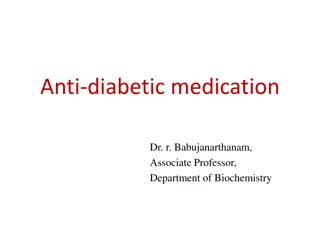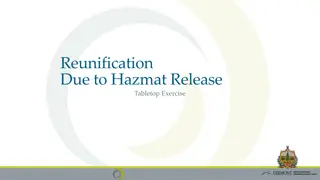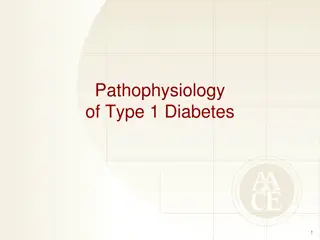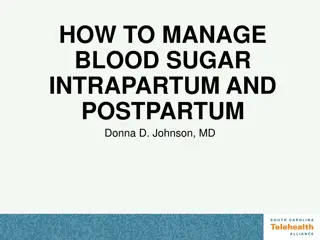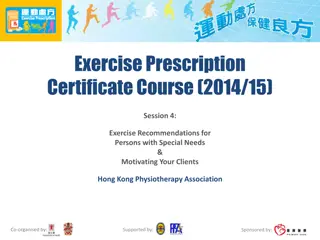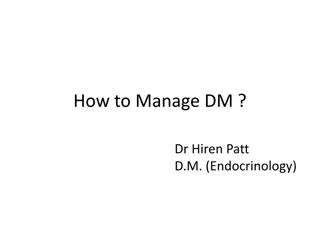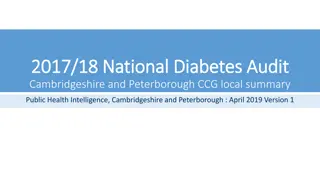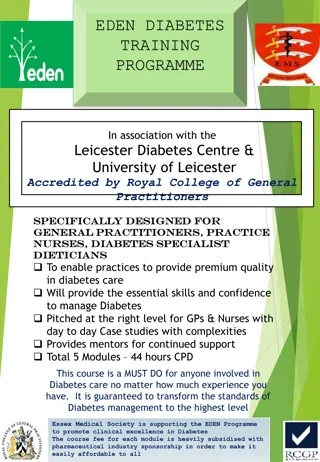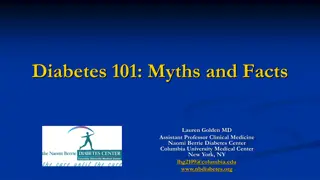Expert Consensus Statement on Exercise for Type 2 Diabetes
This expert consensus statement provides an update on exercise recommendations for individuals with type 2 diabetes (T2D), emphasizing the benefits of physical activity in improving glycemic management, insulin sensitivity, cardiovascular health, and overall disease risk reduction. The document highlights the significance of lifestyle interventions, medication, and bariatric surgery in T2D treatment, with a focus on the consensus-based recommendations derived from current evidence in clinical trials and reviews.
Download Presentation

Please find below an Image/Link to download the presentation.
The content on the website is provided AS IS for your information and personal use only. It may not be sold, licensed, or shared on other websites without obtaining consent from the author. Download presentation by click this link. If you encounter any issues during the download, it is possible that the publisher has removed the file from their server.
E N D
Presentation Transcript
ACSM Expert Consensus Statement on Exercise / Physical Activity for Individuals with Type 2 Diabetes
Purpose of the Update This statement is an update of the 2010 position stand on exercise & type 2 diabetes (T2D) published jointly by the American College of Sports Medicine (ACSM) and the American Diabetes Association (ADA).1 A substantial amount of research on T2D has been published in the last decade with a large focus on the effects of exercise on individuals with T2D. This consensus provides a brief summary of the current evidence along with extensions and updates of the prior recommendations.
Introduction Diabetes affects over 463 million people worldwide2 with a prevalence in the United States of 10.5%.3 T2D accounts for 90-95% of all cases.4 Treatment goals for T2D are to facilitate an individualized treatment plan, including: Education Glycemic management Reduction of cardiovascular disease (CVD) risk Ongoing screening for microvascular complications
Introduction Lifestyle interventions and medication are usually prescribed for treatment of T2D. More recently, bariatric surgery has also become part of a possible treatment plan. Multiple types of physical activity (PA) enhance health and glycemic management in people with T2D. Many of the benefits from PA result from improved insulin sensitivity and body composition, along with CVD risk reductions.
Introduction The current authors used a consensus approach to synthesize available evidence from clinical trials, case reports, narrative and systematic reviews, and meta- analyses. The recommendations represent the consensus of the writing panel and ACSM and incorporate guidance from other professional organizations with expertise in this area, such as the American Diabetes Association (ADA).
Consensus Statements & Recommendations Physical Activity Regular PA enhances: -cell function Insulin sensitivity Vascular function Gut microbiota Can lead to a greater management of diabetes, overall health, and reductions in disease risk.
Consensus Statements & Recommendations Aerobic Exercise Improves glycemic management in adults with T2D Less daily time in hyperglycemia 0.5-0.7% reductions in overall glycemia (measured via A1C) Additional improvements in: Insulin sensitivity Blood lipid profile Blood pressure Weight loss
Consensus Statements & Recommendations Resistance Exercise 10-15% Improvements in: Muscular strength Skeletal muscle mass Insulin sensitivity Bone mineral density Blood pressure Blood lipid profiles High-intensity resistance exercise has greater beneficial effects than low-to-moderate intensity for overall glucose management and attenuation of insulin levels.
Consensus Statements & Recommendations High-Intensity Interval Exercise Improvements in the following: A1C CGM-monitored glycemia Body composition Insulin sensitivity Pancreatic -cell function Body mass index
Consensus Statements & Recommendations Recommendations for Adults with T2D Small doses of PA throughout the day to break up sedentary phases Attenuates postprandial glucose and insulin levels in individuals with insulin resistance and higher BMI. Weight loss of >5% appears to be necessary for beneficial effects on A1C, blood lipids, and blood pressure. Individuals with prediabetes and low PA levels benefit from moderate- intensity walking and other exercise with minimal weight loss. Moderate- to high-intensity exercise (~500 kcal) done 4-5 d/wk reduces abdominal, but particularly visceral, fat in adults with T2D and may lower their metabolic risk
Consensus Statements & Recommendations Recommendations for Adults with T2D Exercises that enhance joint flexibility are highly beneficial for health and well-being in older adults with T2D. Flexibility exercises, alone or in combination with resistance training, improves joint range-of-motion. Many lower body and core resistance exercises double as balance training. Balance exercises may reduce the risk of falls by improving balance and gait, even in adults with peripheral neuropathy.
Consensus Statements & Recommendations In youth with T2D, intensive lifestyle interventions plus metformin have not been superior to metformin alone in managing glycemia. Despite the limited data, it is still recommended that youth and adolescents with T2D meet the same physical activity goals set for youth in the general population.
Consensus Statements & Recommendations Pregnant women with and without diabetes should participate in at least 20-30 minutes of moderate-intensity exercise most days of the week. Individuals with T2D using insulin or insulin secretagogues may need to supplement with carbohydrates to prevent hypoglycemia around or during exercise. Participation in an exercise program prior to bariatric surgery may enhance surgical outcomes, and after surgery participation confers additional benefits.
Conclusions Various types of PA, including exercise, can greatly enhance the physical and mental health and glycemic management of individuals with T2DM. The Physical Activity Guidelines for Americans (2018) are applicable to most individuals with diabetes, including youth, with a few exceptions and modifications. All individuals should engage in regular PA, reduce sedentary behavior, and break up elongated sitting time with frequent activity sessions.
References 1. Colberg SR, Albright AL, Blissmer BJ, Braun B, Chasan-Taber L, Fernhall B, et al. Exercise and type 2 diabetes: American College of Sports Medicine and the American Diabetes Association: joint position statement. Exercise and type 2 diabetes. Med Sci Sports Exerc. 2010;42(12):2282-303. Saeedi P, Petersohn I, Salpea P, Malanda B, Karuranga S, Unwin N, et al. Global and regional diabetes prevalence estimates for 2019 and projections for 2030 and 2045: Results from the International Diabetes Federation Diabetes Atlas, 9th edition. Diabetes Res Clin Pract. 2019;157:107843. Centers for Disease Control and Prevention. National Diabetes Statistics Report, 2020. American Diabetes Association. 2. Classification and Diagnosis of Diabetes: Standards of Medical Care in Diabetes-2021. Diabetes Care. 2021;44(Suppl 1):S15-s33. 2. 3. 4.
Acknowledgements This slide deck was prepared by the ACSM Evidence-Based Practice Committee in collaboration with the authors






